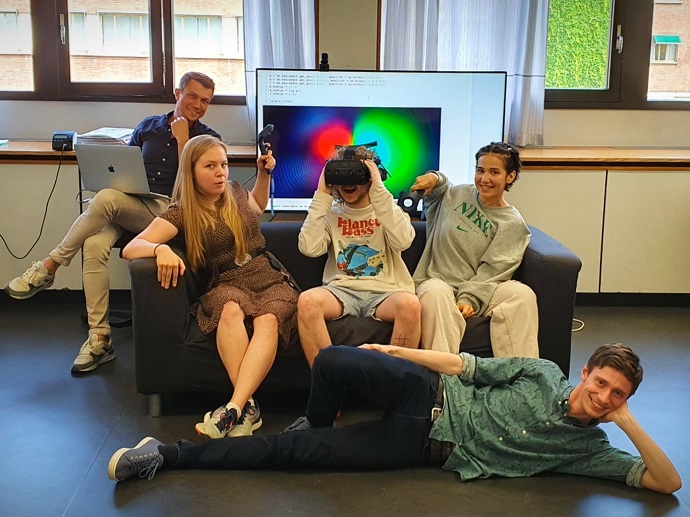During six weeks of CCSE-funded summer internship at the Hylleraas Centre for Quantum Molecular Sciences, Ayla Coder, Elias Dalan and Hanan Gharayba boldly went where nobody has gone before. They explored how virtual reality, interactive simulations and cutting-edge machine learning methods can enhance student learning in chemistry.
Bachelor students on a sidequest in chemistry
The students, ranging from newly graduates to senior bachelor level, presented their results to a cross-disciplinary audience during a seminar at the Center for Computing in Science Education. Their presentation was named "Sidequests in Chemistry", alluding to how challenges outside the main quest line in videogames often are referred to as "sidequests".
Under the supervision of senior lecturer Audun Skau Hansen, the students have explored mainly two overarching questions:
- How can artificial intelligence (AI) assist in experimental work?
- Can virtual reality (VR) and object orientation make emergent phenomena and veiled physical concepts like wavefunctions more tangible and accessible?
New perspectives on learning chemistry
The deep historical roots of chemistry have shaped the way in which the discipline is traditionally taught and understood, through the categorization of subdisciplines and conceptual models used in various subfields.

Increased computational literacy amongst the students, the availability of computational resources and high-level programming languages for simulation and data science are currently opening new pathways between seemingly distant topics in chemistry. Overall this prompts us to explore how this can be utilized in enhancing student understanding in a subject that is known to be difficult.
As examples of such new pathways, Hanan gave the audience a puzzle and simulation regarding the encoding of 3D information in 2D representations. Elias demonstrated how the concept of hybridized orbitals can be made tangible by computing them in 3D and VR. This illustrate how complicated mathematical operations typically required when studying quantum chemistry can be demystified through visually accessible representations.
Finally, Ayla showed how measurements using the HILIC apparatus can be optimized using Gaussian Process Regression and Bayesian Optimization. The approach is based on recent developments in machine learning methods, where empirical data from experiments can be used to make predictions with consistent treatment of error estimates.
The approach will be integrated as a laboratory exercise in analytical chemistry in the spring of 2023.
Making science more accessible
Due to how computing and computational thinking is currently being integrated throughout the educational system, theoretical chemistry is becoming increasingly relevant and accessible to a broad group of students.
In their internship, the students piloted new software being developed at the Hylleraas-centre.
Furthermore, the application of machine learning methods in the laboratory and virtual reality is likely to be relevant to a wide range of topics within the natural sciences.
Senior lecturer Audun Skau Hansen has great expectations that machine learning could perhaps even be used in connecting themes across the disciplines.
More information about the project
Contact Senior lecturer Audun Skau Hansen
Know more about the project: "Open World Learning framework" (external website)
